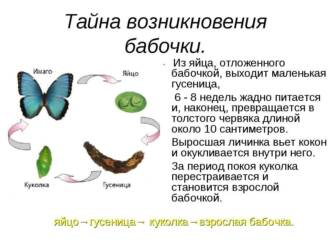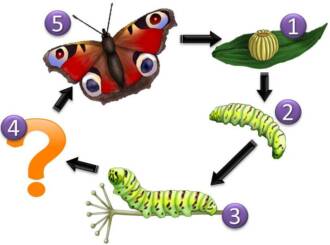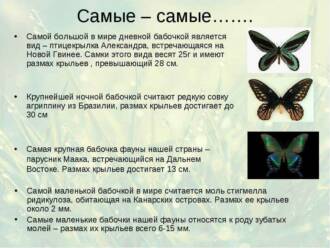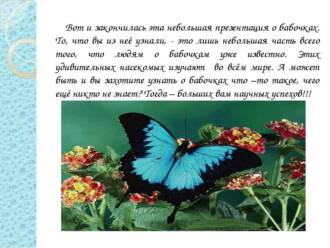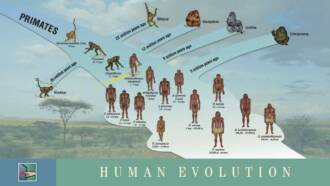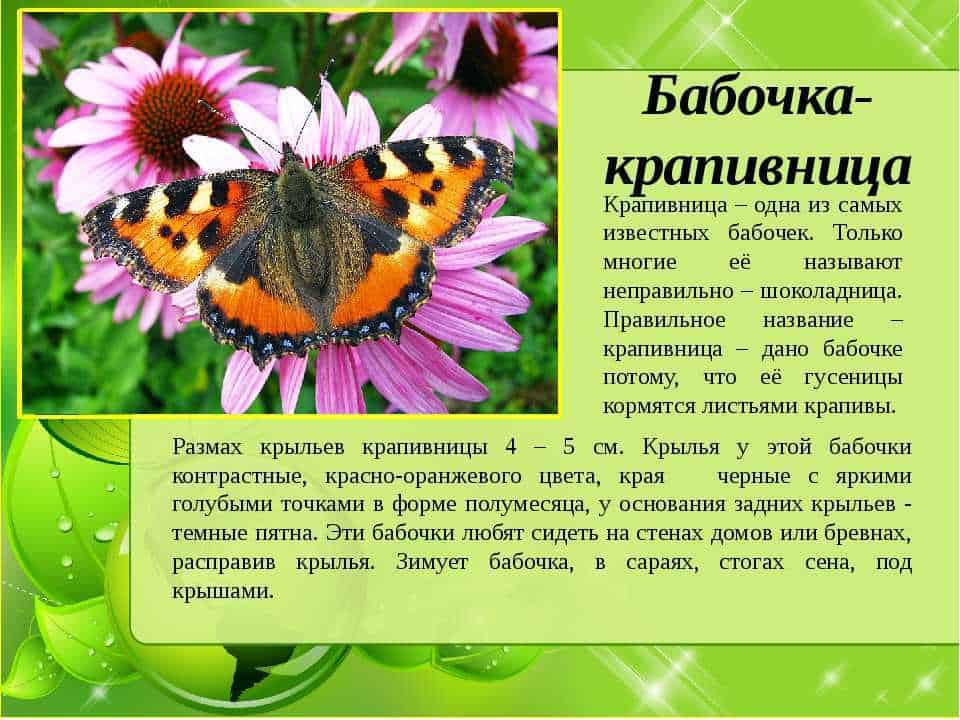
Butterflies are beautiful and delicate insects that can please us with their beauty and ease of flight. Children love to look at these beauties and rejoice when they appear in the garden. But how does a butterfly appear?
It all starts with an egg. Butterflies lay their eggs on the leaves or flowers of plants. The eggs are usually very small and round. When the egg hatches, a hungry caterpillar emerges from it.
The caterpillar is the youngest stage of a butterfly's life. She constantly eats the leaves and flowers of plants in order to grow and become stronger. Caterpillars can be of different colors and sizes, but they are all hungry and active.
After a while, the caterpillar stops eating and begins to turn into a chrysalis. The pupa is a special shell in which internal changes occur. A butterfly emerges from a chrysalis! She crawls out of her chrysalis and spreads her wings. Now she is ready to fly and delight us with her beauty.
How a butterfly is formed
1. Butterfly eggs
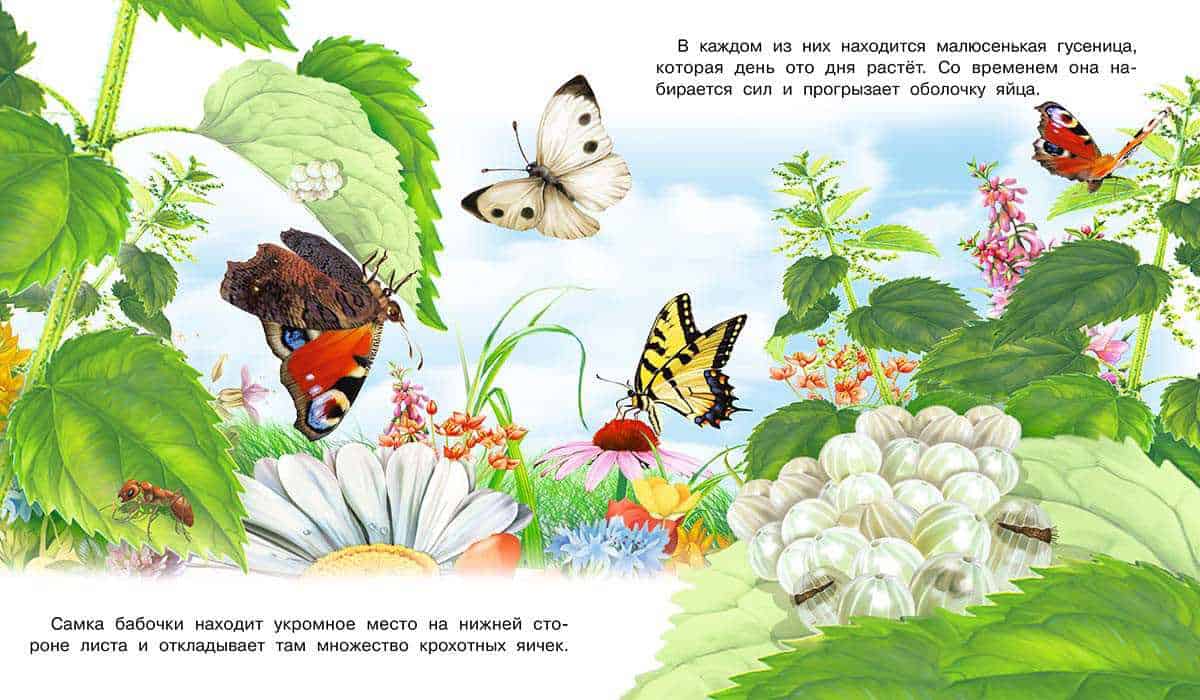
A butterfly begins its life as an egg. Butterfly eggs can be of different sizes and shapes, depending on the species. They are usually placed on the leaves of plants that will serve as food for the future caterpillar.
2. Caterpillar

A caterpillar hatches from an egg. Butterfly caterpillars have a long body and many legs. They actively feed to gain strength for the next stage of their lives. Caterpillars eat leaves, flowers, and other parts of plants.
3. Pupa
After the caterpillar is full, it turns into a chrysalis. The chrysalis is the resting stage of a butterfly's life when it is in a hard shell called a cocoon. Inside the cocoon, changes occur: the caterpillar body decomposes, and a new butterfly body is formed.
4. Butterfly
Finally, a butterfly flies out of the chrysalis. After the butterfly breaks through the cocoon, it unfolds its wings and spills out. The butterfly starts its new life and is ready to explore the world around it.
Thus, a butterfly goes through several stages of its development: from egg to caterpillar, from caterpillar to pupa, and finally from pupa to butterfly. This process is called metamorphosis and is amazing and unique to butterflies.
Stages of butterfly metamorphosis

The process of turning a caterpillar into a butterfly is called metamorphosis. This whole process goes through several stages, each of which will surprise children with its uniqueness and beauty.
1. Egg
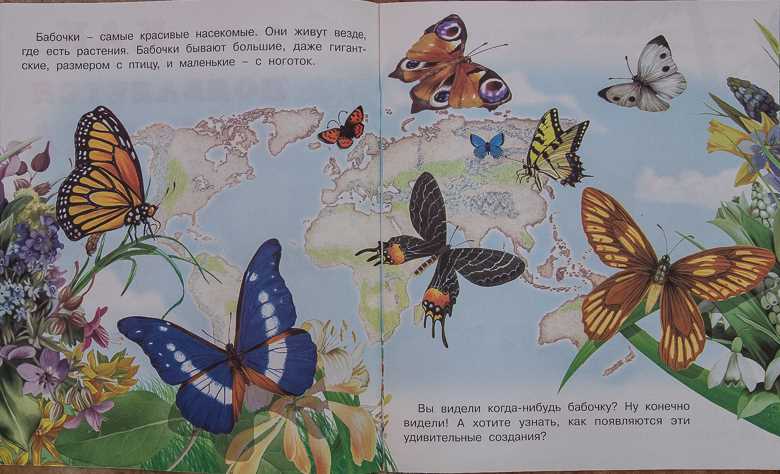
The first stage of metamorphosis is the egg stage. The butterfly lays eggs on plants that will serve as food for the future caterpillar. The eggs often have different shapes and colors and can be seen on the leaves and stems of plants. Once the egg hatches, the next stage begins - the caterpillar stage.
2. Caterpillar
The caterpillar is the second stage of metamorphosis. Caterpillars are very diverse and can be of different colors and sizes. They actively feed on plants to gain strength for the next stages. Caterpillars grow and develop very quickly, their main task is to collect enough food before turning into a pupa.
3. Pupa
Pupa is the third stage of metamorphosis. The caterpillar turns into a chrysalis, hiding in its protective case. Externally, the chrysalis may resemble a dead leaf or a bark-covered tree. Inside the chrysalis, amazing changes occur: the caterpillar's body disintegrates and turns into a butterfly. This stage can last from several days to several months, depending on the type of butterfly.
4. Butterfly
The final stage of metamorphosis is the emergence of the butterfly. Once the butterfly has fully formed inside the chrysalis, it breaks its shell and flies out. The butterfly usually has beautiful multi-colored wings that help it move around and attract males. The butterfly spends its life as a forager and a breeding partner until it is time to lay eggs and begin a new cycle of metamorphosis.
egg development
How does a butterfly appear in pictures for children?
The first stage in the development of a butterfly is an egg. Butterfly eggs are usually very small and round, like a grain of sand. They can be of different shapes and colors, depending on the type of butterfly. Eggs are usually laid on plants that serve as food for future caterpillars.
After the egg has been laid, it begins to develop. Inside the egg is a small embryo, which gradually turns into a caterpillar. Within a few days or weeks, depending on the species, the egg sprouts and hatches into a small caterpillar.
The caterpillar is the second stage in the development of the butterfly. It has a long body and many legs. The caterpillar grows and develops, eating plant foods. Some caterpillars can eat a large number of leaves in a day. During its growth, the caterpillar goes through several stages of molting, when it breaks through its old skin to grow.
After the completion of the last stage of molting, the caterpillar begins preparations for the next stage of development - the chrysalis. The caterpillar is looking for a secluded place where it can safely turn into a chrysalis. She attaches her body to a branch or leaf and begins the transformation process.
Caterpillar development
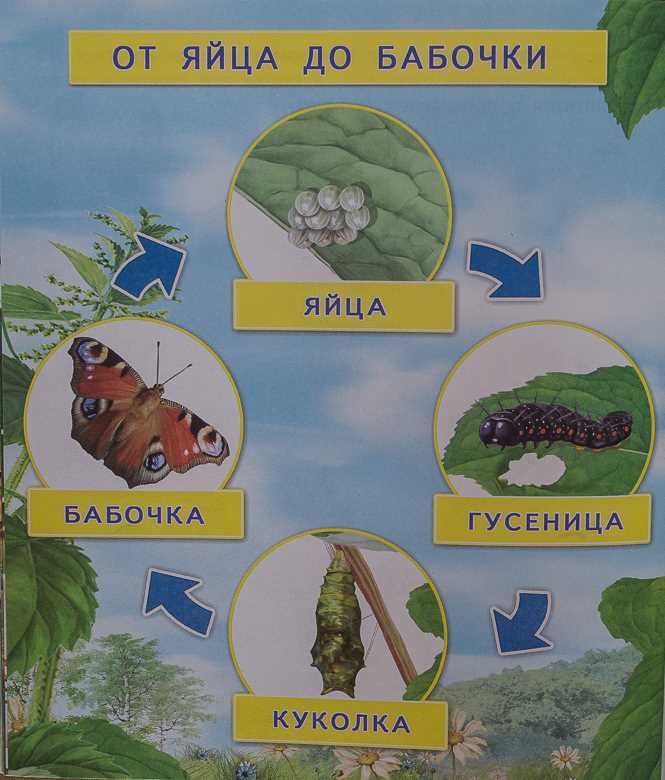
The caterpillar is the first stage in the development of a butterfly. It emerges from an egg that a female butterfly lays on a leaf of a plant. The caterpillar hatches from the egg and begins to feed on the leaves in order to obtain nutrients for its growth.
As the caterpillar grows, it goes through several molts as it sheds its old skin and renews it with new. During each molt, the caterpillar gets bigger and bigger. When the caterpillar reaches a certain size, it is ready to become a chrysalis.
The caterpillar begins building its cocoon, from which the butterfly will later emerge. It attaches the cocoon to a plant branch or other suitable surface. Inside the cocoon, changes occur in the body of the caterpillar - it turns into a chrysalis.
When the pupa is fully formed, it remains inside the cocoon for some time. Important processes take place inside the pupa, as a result of which the caterpillar turns into a butterfly. After the transformation is completed, the butterfly is ready to emerge from the cocoon and start its new life.
Cocoon caterpillar cover
As the caterpillar prepares to transform into a butterfly, it begins to build its cocoon. The caterpillar uses its glandular glands to secrete threads from which it weaves its protective shell. The cocoon serves as a shelter for the caterpillar during its transformation.
The caterpillar wraps itself in a cocoon, tying threads to surrounding objects such as branches or leaves. It creates a strong and durable structure that protects it from predators and the weather.
The cocoon of a caterpillar can have various shapes and sizes depending on the type of butterfly. Some cocoons are smooth and dense, while others may be rough or spiked for added protection.
When the caterpillar completes its transformation inside the cocoon, it becomes a chrysalis. Magical changes take place inside the chrysalis, and after a while an adult butterfly emerges from it.
So, the covering of the cocoon by the caterpillar plays an important role in the life cycle of the butterfly. It provides protection and security for the caterpillar during its transformation, allowing it to eventually transform into a beautiful butterfly.
Transformation into a chrysalis
How does a butterfly appear in pictures for children? The process of transformation of a butterfly begins with the appearance of a chrysalis, which is called a caterpillar. A caterpillar is the first stage of development of a butterfly. It usually has a long body and many legs. Caterpillars of different species can be multi-colored and have different patterns on their bodies.
When the caterpillar grows and becomes larger, it moves to the next stage of its development - the pupa stage. The pupa is a special protective case that is formed from the caterpillar's skin. Inside the pupa, amazing changes occur: the caterpillar turns into a butterfly.
The process of turning a caterpillar into a chrysalis is called molting. During molting, the caterpillar sheds its old skin and forms a new, stronger one. She then attaches herself to a branch or leaf and begins to build a chrysalis. The pupa is oval or capsule shaped and usually has beautiful color or patterns to hide it from predators.
Magical changes take place inside the chrysalis. The caterpillar turns into a butterfly by metamorphosis. Inside the pupa there are changes in appearance, as well as internal organs. When the transformation is completed, the chrysalis ruptures, and an adult butterfly flies out of it.
Butterfly development inside the chrysalis
Have you ever wondered how a butterfly is born? Here is some interesting information for you and your children. When a butterfly first begins its life, it is inside a chrysalis. The chrysalis is a kind of dwelling where an important development process takes place.
Inside the chrysalis, the butterfly is at rest. But at this time, amazing changes are taking place. Inside the chrysalis, the caterpillar transforms into a butterfly. How does this happen?
First, inside the chrysalis, the caterpillar begins to transform into a chrysalis. It grows a hard covering that protects it from external influences. Then the most interesting part begins - the caterpillar's body is transformed.
Changes take place inside the chrysalis that cannot be seen with the eye. The caterpillar sheds its old skin and turns into an adult butterfly. When the process is completed, the chrysalis splits and a new butterfly flies out into the light.
Butterfly hatching
How does a butterfly appear in pictures for children? Butterfly hatching is an amazing process that occurs after the butterfly has gone through the egg and caterpillar stages. When the caterpillar is ready to metamorphose, it forms a cocoon or chrysalis, inside which incredible changes occur.
During the hatching of the butterfly, the caterpillar turns into a beautiful insect with wings, and this happens inside the cocoon. The hatching process begins with the butterfly making a small slit in its cocoon. Through this gap, she begins to push her body and wings.
When the butterfly finally hatches, it remains on the cocoon and rests for a while. At this time, her wings unfold and take on their full form. The butterfly then begins pumping blood into its body to make its wings strong and ready to fly.
Thus, the hatching of a butterfly is an amazing process of transformation of a caterpillar into a beautiful insect. This process can be seen in pictures and photographs that will help children better understand and appreciate the magic of nature.
The first minutes of a butterfly's life
How does a butterfly appear in pictures for children? In the first minutes of its life, a butterfly undergoes amazing changes. After the butterfly cuts the cocoon with a blade, it comes out as a small and soft creature.
Immediately after hatching, the butterfly must unfold its wings and dry them. They are wet and twisted, but over time they straighten out and become strong.
In the first minutes of a butterfly's life, it cannot yet fly. She rests and gains strength to become a full member of the butterfly world. At this time, she also adjusts to her new lifestyle.
The first minutes of a butterfly's life are a special and amazing moment. At this moment, she transforms from a caterpillar into a beautiful and delicate butterfly. How a butterfly appears in pictures for children can be seen in illustrations and photographs.
Butterfly food
Butterfly nutrition is one of the important aspects of its life cycle. As a butterfly appears in pictures for children, so its nutrition is of interest to kids.
Butterflies feed on nectar they get from flowers. The nectar contains sugars and gives the butterflies the energy to fly and reproduce. Butterflies have long, thin mouthparts called proboscises, which they use to reach the nectar inside the flower.
But not all butterflies feed only on nectar. Some species of butterflies also feed on pollen, tree sap, or other plant sap. They use their proboscis to absorb these nutrients.
When the butterfly is in its caterpillar stage, it feeds on leaves and other plant materials. Caterpillars can be specialized in feeding on certain types of plants or be polyphages, that is, they feed on different types of plants.
Thus, butterflies have a varied diet that plays an important role in their life cycle and helps them survive and reproduce.
Butterfly breeding
Butterfly reproduction is an amazing and exciting process that occurs in nature. It begins with soaring, when the male and female butterflies are attracted to the scent and color of the flower. The male flies to the female and transfers sperm to her with the help of a special organ.
After that, the female begins to lay eggs on plants that will serve as future food for the caterpillars. Butterfly eggs can be of different colors and sizes, but they are always very beautiful.
The eggs hatch into caterpillars, which begin active feeding in order to gain strength before turning into a chrysalis. Caterpillars can eat leaves, stems and fruits of plants, their appetite is amazing in its strength.
When the caterpillar has already gained enough nutrients, it turns into a chrysalis, which resembles a small bag or pebble. Amazing transformations take place inside the chrysalis, and after a while an adult butterfly hatches from it.
This moment when a butterfly appears is very important and exciting. She penetrates the world of insects and begins her independent existence. The butterfly is ready for new adventures, it is ready to fly and delight us with its beauty.
Butterfly protection methods
Butterflies are beautiful and delicate insects that can be endangered by various factors. There are several ways to protect these colorful creatures.
1. Preserve their natural habitat
Butterflies usually live in various places: in forests, in meadows, in gardens and parks. It is important to preserve their natural habitat so that they can find food and a place to breed. It is necessary to preserve forests, not pollute water bodies and not cut down gardens so that butterflies can fly and breed freely.
2. Limiting the use of chemicals
Chemicals such as pesticides and herbicides can be harmful to butterflies. They can poison them or destroy their natural food. Therefore, it is important to limit the use of chemicals in gardens and fields so as not to harm butterflies and other insects.
3. Creation of special gardens for butterflies
To help the butterflies, you can create special gardens where they can find food and a place to live. In such gardens, you can plant plants that attract butterflies, such as euphorbia, periwinkle and sunflower. You can also install special butterfly feeders, where you can place a sugar solution or a special mass for feeding.
All these ways will help to save butterflies and their beauty. It is important to remember that our care and attention can make the world a better place for these gentle creatures.


